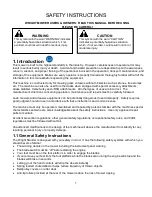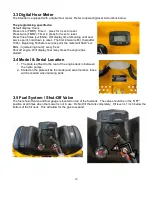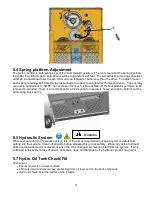
9
the mower very slowly, inching it backward until you become familiar with how the mower operates. Always
operate slowly if in an awkward location or position. While backing up never place your foot or feet on the
ground near the back edge of the mower to prevent serious personal injury if the mower were to run over
you.
1.14 Zero-Radius Turn Operation
During zero-radius turns (when one mower wheel rotates backwards while the other rotates forward) drive
extra slowly to reduce the possibility of losing traction, or control, or becoming dizzy. This will help prevent
you from being thrown off the mower. Be aware that if you do a turn on a slope you may go through all of the
orientations to a slope mentioned below and must handle the mower accordingly.
1.15 Operation on Slopes
DO NOT operate on steep slopes 25 degrees or greater for long periods or engine damage may occur. Do
not operate the mower on slopes steeper than you can feel secure about the traction of the tires and the
stability of the mower. Do not operate the mower on slopes at all when the grass is wet. There is a danger
of suddenly sliding sideways or down the hill. When operating on a slope, travel across the grade whenever
possible, not in an up or down pattern. Reduce speed and exercise extreme caution on slopes and in sharp
turns to prevent tipping or loss of control. Be especially cautious when changing direction on slopes.
When pointing up a slope, your mower has the most weight on the drive wheels and therefore the most
traction at the tires. However, this is the angle that it has the most tendency to tip back (“pop a wheelie.”)
This is the preferred angle for mowing small areas of steeper slopes.
Recommendations for this angle:
•
Lean as far forward as possible to add your weight to the front of the mower.
•
Accelerate gently. Do not accelerate quickly to avoid “popping a wheelie”.
•
If backing down the hill, do not stop suddenly but slow down gradually.
When pointing down a slope, your mower has the least weight on the rear drive wheels and therefore the
least traction at the tires. This is the angle that the mower has the most tendency to slide. However, this is
the angle that it has the least tendency to tip back. Avoid this angle, as it has the least advantage for your
mower.
Recommendations for this angle:
•
Lean back with arms stretched out straight while holding onto the stationary handlebar. This transfers
more of your body weight to the rear drive wheels for more traction.
•
Do not change speed suddenly to minimize the tendency of going into a slide. Accelerate and decelerate
gently. If you ever go into an uncontrolled slide while pointing down a slope the recommended procedure
is to let go of the handles and jump off if necessary. Otherwise, control the mower gently and stay off
slopes that tend to make the wheels slide.
When crossing a slope sideways, your mower has the average amount of weight on the drive wheels
versus the front wheels, similar to level ground. However, this angle leaves the least weight on the higher
side drive wheel, tending to make it slip. This is the preferred angle for mowing large areas of gentle
slopes.
Recommendations for this angle:
Lean back. This adds weight to the rear drive wheels and will allow you to mow more quickly across the
slope without sliding. These are general guidelines only. The mower function and comfort will vary
depending on mowing environment, operator driving style and preference.
•
To reduce the chances of “popping-a-wheelie”, do not accelerate quickly.
WARNING
WARNING
Summary of Contents for Stander
Page 29: ...28 Date Maintenance Service Performed Unit Hours Shop Technician Maintenance Record ...
Page 37: ...37 NOTES ...
Page 38: ...Notes ...
Page 39: ......
Page 40: ...4600X Wedgewood Blvd Frederick MD 21703 www wrightmfg com ...











































